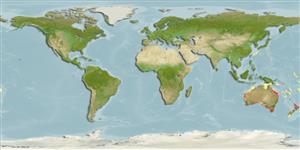Common names from other countries
>
Anguilliformes (Eels and morays) >
Ophichthidae (Snake eels) > Myrophinae
Etymology: Scolecenchelys: Greek, skolex = worm (1855) + Greek, enchlys, -yos = eel (Ref. 45335).
More on author: Macleay.
Environment: milieu / climate zone / depth range / distribution range
Ecologia
marinhas demersal; intervalo de profundidade 0 - 50 m (Ref. 104540). Temperate
Southwest Pacific: restricted to southeastern coast of Australia, Tasmania, and New Zealand.
Tamanho / Peso / Idade
Maturity: Lm ? range ? - ? cm
Max length : 40.0 cm TL macho/indeterminado; (Ref. 33839)
Descrição breve
Chaves de identificação | Morfologia | Morfometria
Vértebras: 145 - 156. This species of the Scolecenchelys gymnota species group is distinguished by the following set of characters: head 7.7-8.9 % TL (in large specimens, >18.0 cm TL); tail 55-58 % TL; trunk 34-36 % TL; horizontal distance between origin of dorsal-fin and a vertical through mid-anus 8.0-91 % HL; jaws and vomerine teeth in a single row, rarely biserial anteriorly and uniserial posteriorly; predorsal vertebrae 62-68, preanal 60-63 and total 145-156; MVF 65-61-151 (Ref. 104540).
A shallow species (< 50 m) found in among seagrass beds and rocky tidepools (Ref. 104540). Lives in groups of many individuals. Feeds on small bottom-dwelling invertebrates (Ref. 33839).
Life cycle and mating behavior
Maturities | Reprodução | Spawnings | Egg(s) | Fecundities | Larvas
Hibino, Y. and S. Kimura, 2015. Revision of the Scolecenchelys gymnota species group with descriptions of two new species (Anguilliformes: Ophichthidae: Myrophinae). Ichthyol Res (Ref. 104540)
Categoria na Lista Vermelha da IUCN (Ref. 130435)
CITES (Ref. 128078)
Not Evaluated
Ameaça para o homem
Harmless
Utilização humana
Ferramentas
Relatórios especiais
Descarregue XML
Fontes da internet
Estimates based on models
Preferred temperature (Ref.
115969): 14.8 - 23.3, mean 17.4 (based on 144 cells).
Phylogenetic diversity index (Ref.
82804): PD
50 = 0.5000 [Uniqueness, from 0.5 = low to 2.0 = high].
Bayesian length-weight: a=0.00076 (0.00029 - 0.00199), b=3.06 (2.83 - 3.29), in cm Total Length, based on LWR estimates for this (Sub)family-body shape (Ref.
93245).
Nível Trófico (Ref.
69278): 3.5 ±0.0 se; based on diet studies.
Resiliência (Ref.
120179): Elevada, tempo mínimo de duplicação da população menor que 15 meses (Preliminary K or Fecundity.).
Fishing Vulnerability (Ref.
59153): Low to moderate vulnerability (30 of 100).
